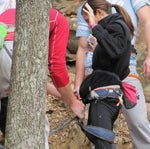Lowered Off Gear Loop And Other Dangerous Behavior

"HPHarness"
When doing a regular risk assessment at my climbing facility, I watched a girl reach the top of one of our taller routes (85 feet). When she let go to be lowered to the ground, something looked very off. She was facing backwards, almost as if she were rappelling aussie-style. When she reached the ground, it turned out she was clipped into a gear loop.—Submitted by Morgan Gerville-Reache, via Climbing.com
LESSON: 85 feet is a long way to depend on a gear loop. Some gear loops, like those on the Metolius Safe Tech Harness, are made to withstand 9 kn of force. Others are only made to hold 12 lbs. Regardless, the strongest points on your harness will always be the belay loop and the tie-in points. As the name implies, the tie-in points are the best place for tying in. Use them. Furthermore, errors like this can be avoided by simply double-checking your partner’s knot before leaving the ground every time you climb.

Seen at Foster Falls, TN. Some guys tyed an extra small girl into one of their extra large harnesses (see right). Her waist could’ve fit through the leg loop!—Submitted by Clayton Astroturf, via Facebook
LESSON: Oh boy. Harnesses only work if you can’t slide out of them. The general guideline is no more than two fingers worth of space between you and the tightened waist loop. The leg loops are a little more up to personal preference, but tighter legs will be more comfortable when hang dogging. If your harness fits like a hula hoop, go bouldering instead.
I took some friends who had never climbed before to a local crag. I was belaying one friend while speaking to another, when I looked up to find a bowling ball-sized rock hurtling towards us. I yelled “ROCK!” and the bystanders had just enough time to dodge out of its path before it exploded on the ground next to us. The climber knew the rock had fallen, but didn’t give any of us a signal. If I hadn’t been looking, someone might’ve been seriously injured.—Submitted by Devin, via Climbing.com
LESSON: As I’m sure you’ve realized Devin, this one’s on you. When you introduce someone to climbing, they’re only aware of what you’ve taught them. Falling rock is a serious danger. Everyone at the cliff should know to yell “rock” when they see any falling rock. Also, while it won’t make you invincible, a helmet will protect you from most smaller stones. Just don’t look up when you hear “Rock!” You want the projectile to deflect off your dome protector, not cream you in the face. Bonus tip: If you’d been watching your climber like a good belayer, you would’ve seen that rock the second it came off the wall.
Also Read: The Pros and Cons of Simul-Rappelling
Want more? Check out more installments in our ever-growing hall of dangerous behavior:
They Used Parachute Cord For Slings
No belay Anchor on Multi Pitch, and Leader Falls
Lucky He Didn’t Die. Lowered From a Toy Carabiner
Unfortunate Groundfall, Fortunate Landing
Leader Decks When Experienced Climber Bungles the Belay
Saw Through Someone Else’s Rope
Belayed With Hands Only—No Device!
Smoke Brick Weed and Go Climbing
Belay With a Knife In Your Hand